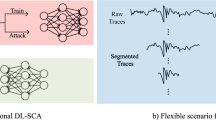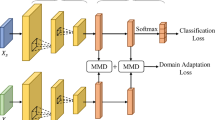Abstract
There has been a growing interest in the side-channel analysis (SCA) field based on deep learning (DL) technology. Various DL network or model has been developed to improve the efficiency of SCA. However, few studies have investigated the impact of the different models on attack results and the exact relationship between power consumption traces and intermediate values. Based on the convolutional neural network and the autoencoder, this paper proposes a Template Analysis Pre-trained DL Classification model named TAPDC which contains three sub-networks. The TAPDC model detects the periodicity of power trace, relating power to the intermediate values and mining the deeper features by the multi-layer convolutional net. We implement the TAPDC model and compare it with two classical models in a fair experiment. The evaluative results show that the TAPDC model with autoencoder and deep convolution feature extraction structure in SCA can more effectively extract information from power consumption trace. Also, Using the classifier layer, this model links power information to the probability of intermediate value. It completes the conversion from power trace to intermediate values and greatly improves the efficiency of the power attack.
Similar content being viewed by others
Explore related subjects
Discover the latest articles and news from researchers in related subjects, suggested using machine learning.References
Jaegeun M, Im Y Jung, Hyuk J P. IoT application protection against power analysis attack. Computers and Electrical Engineering, 2018, 67: 566–578
Brier E, Clavier C, Olivier F. Correlation power analysis with a leakage model. In: Proceedings of International Conference on Cryptographic Hardware and Embedded Systems. 2004, 16–29
Chang J, Wang H, Wang F, Zhang A, Ji Y. RKA security for identity-based signature scheme. IEEE Access, 2020, 8: 17833–17841
Mangard S, Pramstaller N, Oswald E. Successfully attacking masked AES hardware implementations. In: Proceedings of International Conference on Cryptographic Hardware and Embedded Systems. 2005, 157–171
Van Cleemput J, De Sutter B, De Bosschere B. Adaptive compiler strategies for mitigating timing side channel attacks. IEEE Transactions on Dependable and Secure Computing, 2020, 17(1): 35–49
Yoshikawa M, Nozaki Y, Asahi K. Multiple rounds aware power analysis attack for a lightweight cipher SIMECK. In: Proceedings of IEEE Second International Conference on Big Data Computing Service & Applications. 2016, 252–256
GO BS, Le DV, Song MG, Park M, Yu I K. Design and electromagnetic analysis of an induction-type coilgun system with a pulse power module. IEEE Transactions on Plasma Science, 2019, 47(1): 971–976
Kocher P, Jaffe J, Jun B, Rohatgi P. Introduction to differential power analysis. Journal of Cryptographic Engineering, 2011, 1(1): 5–27
Carlet C, Faugere J C, Goyet C, Renault G. Analysis of the algebraic side channel attack. Journal of Cryptographic Engineering, 2012, 2(1): 45–62
Ghoshal A, Patranabis S, Mukhopadhyay D. Template-based fault injection analysis of block ciphers. In: Proceedings of International Conference on Security, Privacy, and Applied Cryptography Engineering. 2018, 21–36
Wan W, Chen H, Chen J. The attack case of ECDSA on blockchain based on improved simple power analysis. In: Proceedings of International Conference on Artificial Intelligence and Security. 2019, 120–132
Rivest R L. Cryptography and machine learning. In: Proceedings of Advances in Cryptology-ASIACRYPT. 1991, 427–439
Hospodar G, Gierlichs B, Mulder E D, Verbauwhede I, Vandewalle J. Machine learning in side-channel analysis: a first study. Journal of Cryptographic Engineering, 2011, 1(4): 293–302
Heuser A, Zohner M. Intelligent machine homicide-breaking cryptographic devices using support vector machines. In: Proceedings of Constructive Side-Channel Analysis and Secure Design. 2012, 249–264
Bartkewitz T, Lemke-Rust K. Efficient template attacks based on probabilistic multi-class support vector machines. In: Proceedings of Smart Card Research and Advanced Applications. 2012, 263–276
Lerman L, Poussier R, Bontempi G, Markowitch O, Standaert F X. Template attacks vs. machine learning revisited (and the curse of dimensionality in side-channel analysis). In: Proceedings of Constructive Side-Channel Analysis and Secure Design. 2015, 20–33
Martinasek Z, Dzurenda P, Malina L. Profiling power analysis attack based on MLP in DPA contest V4.2. In: Proceedings of International Conference on Telecommunications and Signal Processing. 2016, 223–226
Martinasek Z, Malina L, Trasy K. Profiling power analysis attack based on multi-layer perceptron network. Computational Problems in Science and Engineering, 2015, 343: 317–339
Cagli E, Dumas C, Prouff E. Convolutional neural networks with data augmentation against jitter-based countermeasures. In: Proceedings of International Conference on Cryptographic Hardware and Embedded Systems. 2017, 45–68
Maghrebi H, Portigliatti T, Prouff E. Breaking cryptographic implementations using deep learning techniques. In: Proceedings of International Conference on Security, Privacy, and Applied Cryptography Engineering. 2016, 3–26
Prouff E, Strullu R, Benadjila R, Cagli E, Dumas C. Study of deep learning techniques for side-channel analysis and introduction to ASCAD database. Journal of Cryptographic Engineering, 2020, 10(2): 163–188
Chen R, Wu W, Qi H, Wang J, Wang H. A stacked autoencoder neural network algorithm for breast cancer diagnosis with magnetic detection electrical impedance tomography. IEEE Access, 2020, 8: 5428–5437
Acknowledgements
This research was supported by the National Natural Science Foundation of China (Grant No.61572174), Hunan Province Special Funds of Central Government for Guiding Local Science and Technology Development (2018CT5001), Hunan Provincial Natural Science Foundation of China (2019JJ60004), the Scientific Research Fund of Hunan Provincial Education Department with (19A072), Subject group construction project of Hengyang Normal University (18XKQ02), Application-oriented Special Disciplines, Double First-Class University Project of Hunan Province (Xiang-jiaotong [2018] 469), the Science and Technology Plan Project of Hunan Province (2016TP1020).
Author information
Authors and Affiliations
Corresponding author
Additional information
Yu Ou received a bachelor’s degree from Hengyang Normal University, Hengyang, China, in 2018. He is currently pursuing a master’s degree in the College of Information Science and Engineering, Hunan Normal University, China. His current research interests include embedded systems and information security.
Lang Li received his PhD and Master’s degrees in computer science from Hunan University, China, in 2010 and 2006, respectively, and earned his BS degree in circuits and systems from Hunan Normal University, China in 1996. Since 2011, he has been working as a professor in the College of Computer Science and Technology at the Hengyang Normal University, China. His research interests include embedded computing and information security.
Electronic Supplementary Material
Rights and permissions
About this article
Cite this article
Ou, Y., Li, L. Side-channel analysis attacks based on deep learning network. Front. Comput. Sci. 16, 162303 (2022). https://doi.org/10.1007/s11704-020-0209-4
Received:
Accepted:
Published:
DOI: https://doi.org/10.1007/s11704-020-0209-4




